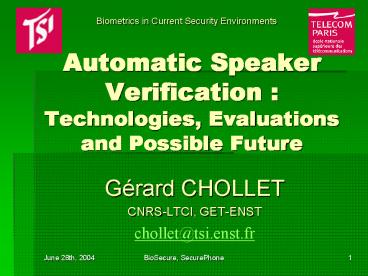Automatic Speaker Verification : Technologies, Evaluations and Possible Future - PowerPoint PPT Presentation
1 / 35
Title:
Automatic Speaker Verification : Technologies, Evaluations and Possible Future
Description:
Title: Visages Parlants pour l authentification biom trique Author: Rapha l Last modified by: G rard Chollet Created Date: 3/23/2004 11:05:16 AM – PowerPoint PPT presentation
Number of Views:135
Avg rating:3.0/5.0
Title: Automatic Speaker Verification : Technologies, Evaluations and Possible Future
1
Automatic Speaker Verification Technologies,
Evaluationsand Possible Future
Biometrics in Current Security Environments
- Gérard CHOLLET
- CNRS-LTCI, GET-ENST
- chollet_at_tsi.enst.fr
2
Outline
- State of affairs (tasks, security, forensic,)
- Speaker characteristics in the speech signal
- Automatic Speaker Verification
- Decision theory
- Text dependent / Text independent
- Imposture (occasional, dedicated)
- Voice transformations
- Audio-visual speaker verification
- Evaluations (algorithms, field tests, ergonomy,)
- Conclusions, Perspectives
3
Why should a computer recognize who is speaking ?
- Protection of individual property (habitation,
bank account, personal data, messages, mobile
phone, PDA,...) - Limited access (secured areas, data bases)
- Personalization (only respond to its masters
voice) - Locate a particular person in an audio-visual
document (information retrieval) - Who is speaking in a meeting ?
- Is a suspect the criminal ? (forensic
applications)
4
Tasks in Automatic Speaker Recognition
- Speaker verification (Voice Biometric)
- Are you really who you claim to be ?
- Identification (Speaker ID)
- Is this speech segment coming from a known
speaker ? - How large is the set of speakers (population of
the world) ? - Speaker detection, segmentation, indexing,
retrieval, tracking - Looking for recordings of a particular speaker
- Combining Speech and Speaker Recognition
- Adaptation to a new speaker, speaker typology
- Personalization in dialogue systems
5
Applications
- Access Control
- Physical facilities, Computer networks, Websites
- Transaction Authentication
- Telephone banking, e-Commerce
- Speech data Management
- Voice messaging, Search engines
- Law Enforcement
- Forensics, Home incarceration
6
Voice Biometric
- Avantages
- Often the only modality over the telephone,
- Low cost (microphone, A/D), Ubiquity
- Possible integration on a smart (SIM) card
- Natural bimodal fusion speaking face
- Disadvantages
- Lack of discretion
- Possibility of imitation and electronic imposture
- Lack of robustness to noise, distortion,
- Temporal drift
7
Speaker Identity in Speech
- Differences in
- Vocal tract shapes and muscular control
- Fundamental frequency (typical values)
- 100 Hz (Male), 200 Hz (Female), 300 Hz (Child)
- Glottal waveform
- Phonotactics
- Lexical usage
- The differences between Voices of Twins is a
limit case - Voices can also be imitated or disguised
8
(No Transcript)
9
Acoutic features
- Short term spectral analysis
10
Intra- and Inter-speaker variability
11
Speaker Verification
- Typology of approaches (EAGLES Handbook)
- Text dependent
- Public password
- Private password
- Customized password
- Text prompted
- Text independent
- Incremental enrolment
- Evaluation
12
History of Speaker Recognition
13
Current approaches
14
HMM structure depends on the application
15
Gaussian Mixture Model
- Parametric representation of the probability
distribution of observations
16
Gaussian Mixture Models
8 Gaussians per mixture
17
Decision theory for identity verification
- Two types of errors
- False rejection (a client is rejected)
- False acceptation (an impostor is accepted)
- Decision theory given an observation O and a
claimed identity - H0 hypothesis it comes from an impostor
- H1 hypothesis it comes from our client
- H1 is chosen if and only if P(H1O) gt P(H0O)
- which could be rewritten (using Bayes law) as
18
Signal detection theory
19
Decision
20
Distribution of scores
21
Detection Error Tradeoff (DET) Curve
22
Evaluation
- Decision cost (FA, FR, priors, costs,)
- Receiver Operating Characteristic Curve
- Reference systems (open software)
- Evaluations (algorithms, field trials, ergonomy,)
23
National Institute of Standards Technology
(NIST)Speaker Verification Evaluations
- Annual evaluation since 1995
- Common paradigm for comparing technologies
24
NIST evaluations Results
25
Combining Speech Recognition and Speaker
Verification.
- Speaker independent phone HMMs
- Selection of segments or segment classes which
are speaker specific - Preliminary evaluations are performed on the NIST
extended data set (one hour of training data per
speaker)
26
ALISP data-driven speech segmentation
27
Searching in client and world speech dictionaries
for speaker verification purposes
28
Fusion
29
Fusion results
30
Speaking Faces Motivations
- A person speaking in front of a camera offers 2
modalities for identity verification (speech and
face). - The sequence of face images and the
synchronisation of speech and lip movements could
be exploited. - Imposture is much more difficult than with single
modalities. - Many PCs, PDAs, mobile phones are equiped with a
camera. Audio-Visual Identity Verification will
offer non-intrusive security for e-commerce,
e-banking,
31
Talking Face Recognition(hybrid verification)
32
Lip features
- Tracking lip movements
33
A talking face model
- Using Hidden Markov Models (HMMs)
34
Morphing, avatars
35
Conclusions, Perspectives
- Deliberate imposture is a challenge for speech
only systems - Verification of identity based on features
extracted from talking faces should be developped - Common databases and evaluation protocols are
necessary - Free access to reference systems will facilitate
future developments































